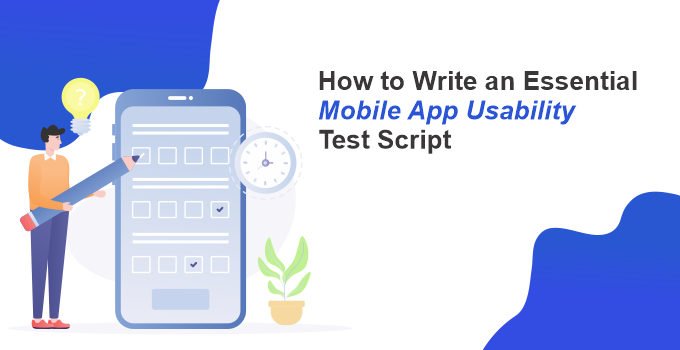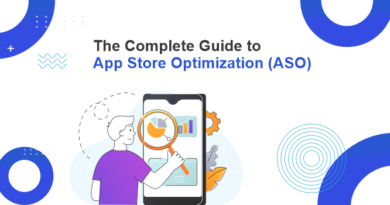How to Write an Essential Mobile App Usability Test SC
When you’re developing a mobile app, user experience testing is critical for determining whether your app will succeed or not. Everything you need to build an effective mobile app is dependent on your test to ensure it is up to par. Mobile apps are essential for business success, and there are also more than 2 million apps available in the app stores. Writing an app usability test script so that you can understand how people use your mobile app will allow you to create websites that convert sales.
This post is aimed at helping you to create your mobile app usability test script by introducing you to the concepts and items that should be included in this essential tool.
Mobile App Usability Testing
Mobile app usability testing is a methodology designed to determine the best design patterns for mobile applications. Utilizing a variety of tools, such as the mobile usability testing application Firebase and Google Tag Manager (GTM), this method explores how users interact with an application. By understanding how users interact with your application, you can identify opportunities to improve its performance and create a more universally appealing product experience.
You’re a lot more likely to make the right decisions about what features deserve the most of your attention when you have a clear idea of how users are responding to them.
Click here to read: The Complete Guide to App Store Optimization (ASO)
Steps Needed to Create a Mobile App Usability Test Plan
The steps to writing a mobile app usability test script are nearly as many as there are mobile app developers. The process of creating a test plan, designing an interface, and designing a user story is similar to writing any other sort of software or web application. Some tips are important to remember about writing a test plan for a mobile application:
1. Backdrop Information
Background information is crucial for mobile app development. Without it, it can be difficult or even impossible to test something on a small scale. Mobile app developers need to consider how best to include this kind of information in their apps.
As part of our process, we include a lot of background information on whom we are and what we do, as well as details about the type and numbers of participants, version history, and testing methodology.
2. Inauguration
The participants who ask more questions tend to have higher achievement, so it’s important to let them pose questions. This will ultimately make it easier for everyone to finish the test. This information will include who we are, what we’re testing, why we’re testing it, and whose product or service is being tested.
There is no right or wrong answer so any response that provides information is valuable. Also, while they are performing the task, you should ask them to speak aloud about their thoughts and actions.
Be sure to ask in advance if you can record a meeting. Be explicit about your request and make sure you’ve gotten verbal consent before recording the session.
3. Questionnaire Before Testing
Mobile testing is a process of communication. To ensure effective communication, participants need time to get comfortable. Basic demographic data is collected to better understand the participants in your test. Confirmation is a good strategy for checking the information you already have.
Even if it’s just a small gesture, showing that you’re in touch with your participants’ needs will establish trust and rapport.
Click here to read: 15 Key Features for a Successful Mobile Commerce App
4. Tasks
A task-centered approach to application usability testing enables you to put all your efforts into the most important part of an app: its tasks. This is how you write a task in a usability script.
Goals
User tasks are specific and actionable statements that indicate an expected goal. If you use them correctly, you’ll give your participants some structure, but you still need to make sure they’re open-ended enough for the participants to express their ideas.
Shape Your Tasks
The participant should generally understand the context, including what the scenarios are supposed to accomplish and why they’re participating in this study. For example, let them know that they’re on a team working on several projects and that they and their teammates are under a tight deadline. Also, it may be useful to provide context by describing what is expected to be done before the task is assigned.
Some other questions can also be added such as:
- What the purpose of this page is?
- What kind of information do you get from this page?
- What will be your next step?
When working on the mobile usability testing script, adding a link for each task to a relevant prototype. It helps in the following ways:
1) It will make the wireframes seem more realistic
2) It allows for the test participant to view other screen examples if they are unsure
3) Saves the time of your test participants, because they do not have to wait for the prototype to load
Also, you can name your tasks and list them in a bulleted list. That way your reader will remember what’s on each of the pages could help users complete the tasks. It allows you to use the solution of similar problems the participants have already solved as a guideline. Consequently, you can save on time and resources.
Task Organizing
It is essential to design an efficient and cost-effective system when you use a mobile app to write. Just like any other task, writing tasks should be separated into mini-tasks with respective due dates and times. Due dates can be arranged so that each task gets done on time without adding much extra stress on yourself; however, you should still set due dates for each task as otherwise the whole process might get thrown off anyway because of an unclear schedule or simply because some of the scheduled tasks might not be done on time.
5. Questionnaire on End
The core test is the initial part of the test script. It consists of a short set of questions designed to quickly and efficiently measure whether users can use your site’s most important functionality. You can ask participants to articulate their expectations of the feature or the product, or if they thought they would receive different functionality. You can ask them if they have any suggestions for this app you could add or if there is any section that could be improved.
6. Thank You Section
Your users have given you their time, and you should be grateful for that. Before ending the session, you can also ask participants if they have any questions for you, or confirm with them how they are compensated.
Importance of Writing Mobile App Usability Test
- It enables you to define the requirements of the app better and understand its usability to make improvements in design or features
- It shows where the problem areas are and how to improve them
- It offers you advice on how to improve your site’s content
- It gives insights into how people interact with the interface and hence improvise on it to give an enhanced experience
Click here to read: How to Monetize an App? Best App Monetization Strategies
Wrapping up
Mobile apps can cover a wide variety of functions, from quick information to a substitute for websites and Web sites. The latter include websites that need to be kept constantly up to date, like retail. This is true even with the increasing popularity of apps.
An essential mobile app usability test script can help you determine if an app is good enough to warrant the time and effort it requires. An essential test script combines material from user research, storyboarding, testing services, and more. Most usability tests take place over a one- to two-hour period, but they can be expanded and completed based on your team’s needs.



